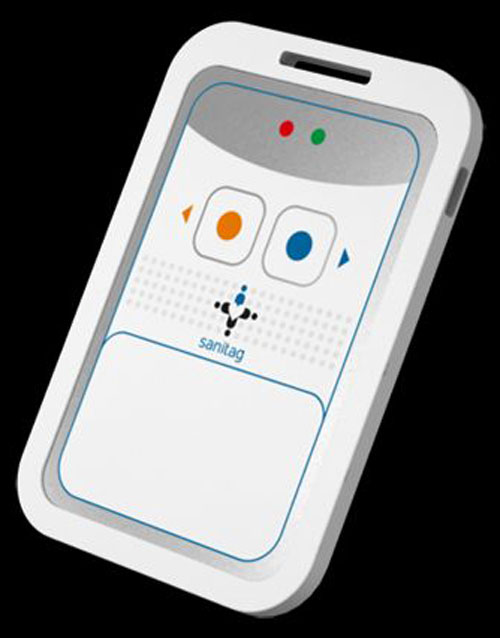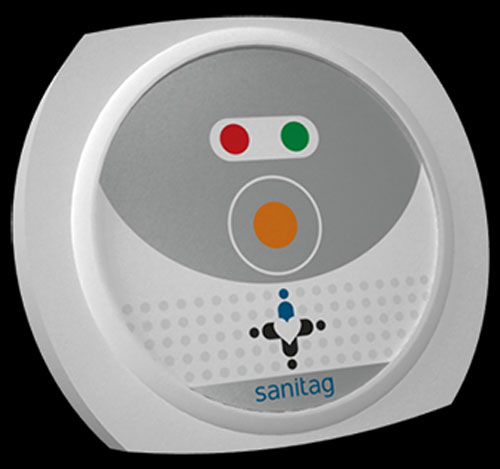Sanitag—a spin-off resulting from a partnership between its parent firm, RFID solutions provider Litum Technologies Corp., and Turkish real-time location system (RTLS) hardware company Wipelot—is marketing full RTLS solutions to the health-care market. The applications include tracking newborn infants, patients, staff members and high-value assets. Sanitag also offers specialized modules tailored for psychiatric clinics or elderly care, either at institutions or in homes. According to Özgür Ülkü, Sanitag’s director of global operations, a customer can deploy specific customizable solutions, separately or in combination, at its facilities.
After exhibiting its solutions at RFID Journal LIVE! 2014, held earlier this month in Orlando, Fla., Sanitag signed agreements with several North American and South American distributors to offer the solution on both continents. In the meantime, Ülkü says, a variety of solutions are being trialed by hospitals in North Africa and the Middle East, and plans for some full deployments are currently underway.

Sanitag’s RTLS solutions are the result of requests that Litum received from its RFID customers. Litum specializes in passive RFID solutions, not specifically designed for health care. However, the company’s distributors were learning from their customers of many use cases for active RFID solutions in the health-care market. Medical facilities required the technology to reduce costs associated with asset tracking, as well as to improve staff efficiency, ensure patient safety and make sure that equipment was available for patients in such mobile settings as in hospitals, on the street as paramedics service patients, or in helicopters as patients are transported to hospitals.
For two years, 40 engineers from Litum Technologies and Wipelot worked to develop a branded solution that employs software to manage data collected from RFID readers, and a 2.4 GHz proprietary standard network of tags and readers to capture that information. The result is multiple solutions, each dedicated for a specific use case.
What the solutions all have in common are Sanitag active RFID tags, including those that can be attached to patient and baby wristbands, an adhesive version for mounting to assets, and a staff badge with two programmable buttons for issuing alerts and performing other tasks. Sanitag then provides an array of room-level readers that plug directly into a power outlet or use batteries, as well as long-range readers for hallways, and routers that receive the 2.4 GHz transmissions from the interrogators and filter that data, then forward it to a server via the hospital’s Wi-Fi network.
Users are encouraged to configure the system the way they need it. For example, Ülkü says, location granularity can be dialed up or down according to need, from 50 centimeters (20 inches) to 10 meters (33 feet), and that range can vary according to a user’s need in multiple zones. For example, a user may want more specific location data in one area, such as an operating room, and less location granularity in another, such as a hallway. The software provides a variety of functions specific to use case as well.
For instance, Ülkü says, the patient tags come with sensors that can detect two different types of events: a possible fall, based on impact to the wristband, and the length of a patient’s idle time, based on a lack of movement. The patient tag also includes a button that a wearer can press to summon a nurse’s help.

The hospital could configure the software to immediately issue alerts via text message or e-mail, or to sound an audible alert if a tag sends data indicating that it has sensed a fall. Physicians could also set parameters for each patient, specific to activity levels. For example, they could set the software to send an alert in the event that data from the beaconing tag indicates the patient has not moved for an hour or two.
Sanitag’s application software includes a module specifically designed for psychiatric clinics, in which each patient could be input into the system and be linked to the unique ID number encoded to his or her wristband, and parameters could then be set up regarding that individual’s movements. For example, one patient may be authorized to enter a specific area at particular times, while another may not be. The software can also be configured in terms of the type of alerts sent if the system detects an unauthorized movement. Messages could be sent to employees, audible alerts could be sounded, or doors or elevators could be locked shut.
In addition, the solution for newborns enables hospitals to set parameters for each infant, in order to ensure that the baby is not removed from the parents or from a hospital’s premises. The staff badges are equipped with alarm buttons, so that if employees are under duress, they can send an alert, which would then be coupled with location data and sent to the appropriate personnel.
Sanitag also provides a mobile unit solution for tracking goods within vehicles. In this case, the firm offers a unit that can be installed on a vehicle. The device not only reads passive or active RFID tags, but also has a GPS unit to identify its location, as well as GPRS transmission capability to send data back to a server.
Customers can use the software on their own back-end system, or as a hosted solution on a Sanitag server. “We have a lot of unique features in our hardware,” Ülkü states. “We wanted to implement unique solutions that could be configured by the user.”
At present, Ülkü says, half a dozen hospitals in the Europe, Middle East and Africa (EMEA) region are carrying out pilots involving Sanitag solutions. For example, one hospital is utilizing the system to monitor what equipment is on its ambulances at all times, thereby ensuring that the equipment necessary to treat a patient en route to that hospital is always present. That solution is being used in both ambulances and helicopters.
In Istanbul, psychiatric patients are being tracked according to geographic zones. In this use case, the hospital’s map is stored on the software, along with details for each patient, indicating which zones on that map he or she can enter. “In this way, they don’t need to have any physical boundaries,” Ülkü explains. The system provides restrictions by identifying if someone leaves his or her authorized zone.
Another hospital is tracking the movements of packages of blood, along with equipment and personnel, in order to ensure that the assets and blood are where they need to be, and to identify where staff members are at any given time. By tracking physicians’ movements, other workers and assets, the facilities can better manage workflow and ensure that patients are being scheduled and seen efficiently.
“We did a lot of market research before we started,” Ülkü says, and his company then defined these use cases as those that would be most in demand. As the pilots continue, he adds, some are already scheduled for permanent deployments. The company now plans to focus on North America and South America as well, by creating partnerships with distributors in those regions.

